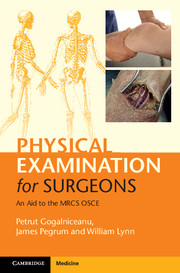Book contents
- Frontmatter
- Dedication
- Contents
- List of contributors
- Introduction
- Acknowledgments
- List of abbreviations
- Section 1 Principles of surgery
- Section 2 General surgery
- Section 3 Breast surgery
- Section 4 Pelvis and perineum
- Section 5 Orthopaedic surgery
- Section 6 Vascular surgery
- Section 7 Heart and thorax
- Section 8 Head and neck surgery
- Section 9 Neurosurgery
- Section 10 Plastic surgery
- Section 11 Surgical radiology
- Section 12 Airway, trauma and critical care
- 63 Examination of the trauma patient
- 64 Examination of the critically ill surgical patient
- 65 Assessment of the airway for intubation
- 66 Assessment of the compromised airway
- 67 Examination of a tracheostomy
- Index
63 - Examination of the trauma patient
from Section 12 - Airway, trauma and critical care
Published online by Cambridge University Press: 05 July 2015
- Frontmatter
- Dedication
- Contents
- List of contributors
- Introduction
- Acknowledgments
- List of abbreviations
- Section 1 Principles of surgery
- Section 2 General surgery
- Section 3 Breast surgery
- Section 4 Pelvis and perineum
- Section 5 Orthopaedic surgery
- Section 6 Vascular surgery
- Section 7 Heart and thorax
- Section 8 Head and neck surgery
- Section 9 Neurosurgery
- Section 10 Plastic surgery
- Section 11 Surgical radiology
- Section 12 Airway, trauma and critical care
- 63 Examination of the trauma patient
- 64 Examination of the critically ill surgical patient
- 65 Assessment of the airway for intubation
- 66 Assessment of the compromised airway
- 67 Examination of a tracheostomy
- Index
Summary
Checklist
System
A-T-I (Assess, Treat, Investigate/Image)
Sequence
ATLS algorithm:
A Airway and C-spine control
B Breathing and ventilation
C Circulation and haemorrhage control
D Disability and neurological deficit
E Exposure and environment
Physiological parameters
• Respiratory rate and oxygen saturation
• Heart rate and blood pressure
• Temperature and blood glucose levels
Airway and C-spine control
Assess
• Cervical spine trauma is inferred from the mechanism of injury, the presence of neck pain or focal neurology in the arms or legs. Patients with polytrauma, unconsciousness or head injuries are presumed to have C-spine injuries unless otherwise proven.
• The airway is assessed by asking the patient to answer a simple question. The ability to phonate implies that the airway is patent.
• Inspect for evidence of a compromised or threatened airway by identifying stridor, hoarse voice, inhalation injuries, facial or laryngeal trauma and the presence of foreign objects in the mouth.
Treat
• The C-spine is controlled by immobilisation with a collar applied to the neck and blocks and tape which secure the neck and collar onto the bed.
• High-flow oxygen (15 L) is given via a non-rebreathe mask.
• The airway is opened by performing a basic manoeuvre (jaw thrust).
• Liquids in the oropharynx (blood, saliva or vomitus) are removed by suction with a Yankauer sucker.
• Solid foreign bodies or loose teeth are removed with Magill's forceps.
• An airway which cannot be spontaneously maintained should be supported with an airway adjunct such as an oropharyngeal or nasopharyngeal airway or laryngeal mask.
• A definitive airway may be established using a cuffed endotracheal tube or tracheostomy tube. In the emergency setting a needle crycothyroidotomy may be created by inserting a wide-bore cannula through the crycothyroid membrane.
Investigate
• Perform an arterial blood gas (ABG).
• Image the cervical spine with an AP and lateral plain film.
- Type
- Chapter
- Information
- Physical Examination for SurgeonsAn Aid to the MRCS OSCE, pp. 473 - 484Publisher: Cambridge University PressPrint publication year: 2015

